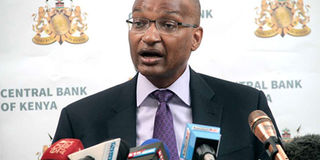CBK faults economic structure as growth prospects fall

Central Bank of Kenya Governor Patrick Njoroge addresses journalists at CBK offices in Nairobi on June 3, 2019. He recently said that increased infrastructure spending has not spread wealth among working Kenyans. PHOTO | FILE | NATION MEDIA GROUP
What you need to know:
- The drop in new jobs and stagnant wages raises queries over equitable distribution of the growth dividend among Kenyans.
- Labour statistics do not capture job cuts and net employment. Companies are struggling with reduced sales and profits in the soft economy.
The Central Bank of Kenya (CBK) has faulted the structure of the country’s economy for delivering economic growth without jobs and a rise in income.
CBK Governor Patrick Njoroge on Monday said households have not felt the growth in the gross domestic product (GDP).
He reckoned that increased infrastructure spending has not spread wealth among working Kenyans.
Dr Njoroge’s comments come at a time when corporate Kenya has witnessed reduced profitability that has ushered in job cuts, a freeze in hiring and near-stagnant wages in the race to protect profit margins amid a 5.6 per cent economic growth in the second quarter to June.
INFRASTRUCTURE
The number of formal jobs generated by the economy fell to a six-year low in 2018, worsening the plight of school leavers in the year that the Jubilee administration recorded its best economic performance with growth at 6.3 per cent.
“It’s true you have GDP numbers, but you can’t eat GDP. At the end of the day, what’s needed is specific income. That is what anybody else wants, plus jobs,” Dr Njoroge said at the International Monetary Fund regional outlook report launch.
“That is why we say central composition of growth is important because if it is just driven by infrastructure that doesn’t quite bring income to your grandmother. She needs to care not because it is 6.5 per cent, but because of what really hits her pocket books,” he said.
Since 2013, Kenya has embarked on major infrastructure projects to make up for decades of under-investment that stunted economic growth.
BORROWING
This is underlined by the construction of the standard gauge railway from Mombasa to Naivasha using nearly Sh500 billion of Chinese loans in a borrowing binge that economists say is saddling future generations with too much debt.
“We may see a very good growth, but we are very much aware that it is not reaching the disadvantaged,” said Mr Geoffrey Mwau, the director of budget at the National Treasury.
The drop in new jobs and stagnant wages raises queries over equitable distribution of the growth dividend among Kenyans, considering that the economy growth expansion witnessed recently.
While Kenya’s economy expanded by 6.3 per cent last year from 4.8 per cent in 2017, private sector activity — which translates to jobs and higher pay — has remained muted.
Mr Jibran Qureishi said: “If you look at employment index (in the PMI) since the beginning of 2017, it’s been quite neutral, meaning it’s not like there has been improvement in new jobs.”
REDUCED PROFITS
Mr Qureishi is the regional economist for East Africa at Stanbic Bank, which tracks company performance monthly through Purchasing Managers’ Index (PMI).
Economic Survey 2019 data shows 78,400 new formal jobs were created in the economy in 2018 compared to 114,400 in 2017.
This is the slowest pace of formal job growth since 2012 when the economy churned out 75,000, adding to the crisis of youth unemployment.
Labour statistics do not capture job cuts and net employment. Companies are struggling with reduced sales and profits in the soft economy.
More than 15 of the 62 companies listed on the Nairobi Securities Exchange (NSE) reported net profit dropped by at least 25 per cent last year compared with 2017.





